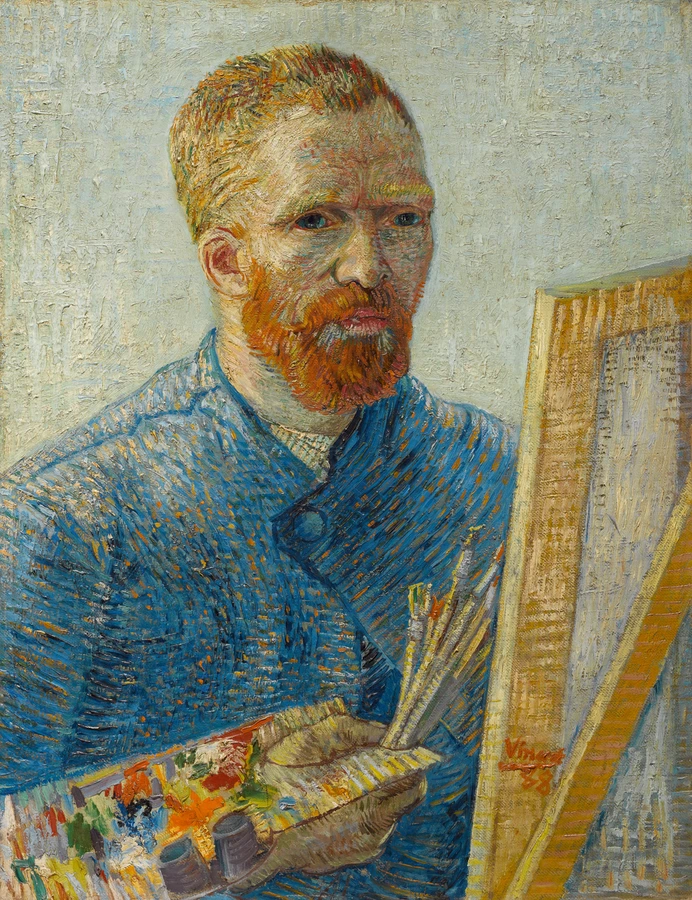Van Gogh / Artaud. The Man Suicided by Society
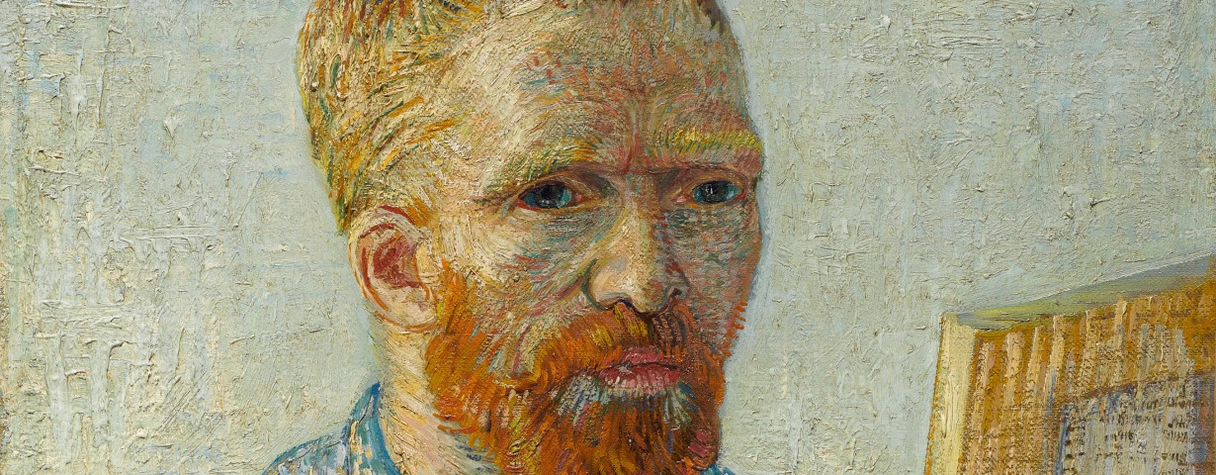
Portrait de l'artiste au chevalet, Paris, décembre 1887-février 1888
Amsterdam, Van Gogh Museum (Fondation Vincent van Gogh)
© Amsterdam, Van Gogh Museum (Fondation Vincent van Gogh) / DR
Van Gogh, The Man Suicided by Society
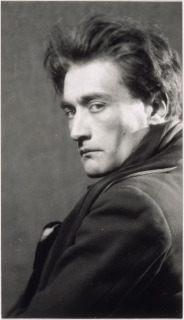
Antonin Artaud, 1926
Paris, Centre Pompidou, Musée national d'Art Moderne / Centre de création industrielle
© Man Ray Trust / ADAGP, Paris © Centre Pompidou, MNAM-CCI, dist. RMN-Grand Palais / Jacques Faujour / Patrice Schmidt
The concept and design of this exhibition is based on the essay by Antonin Artaud (1896-1948), Van Gogh, the Man Suicided by Society.
In late 1946, Pierre Loeb (1897-1964), founder of the Galerie Pierre in Paris, suggested to Artaud that he should write about Van Gogh, believing that after a nine-year stay in a psychiatric hospital he was eminently well qualified as an artist to write about a painter deemed to be mad. Artaud was in the process of preparing his works for publication and was not enthusiastic about the project.
He was spurred to action by the publication of excerpts from psychiatrist François-Joachim Beer's book, Van Gogh's Demonto coincide with the opening of a Van Gogh exhibition at the Musée de l'Orangerie in Paris in late January 1947. Artaud was incensed by Beer's clinical portrayal of the painter's madness and challenged this analysis, accusing society as a whole of driving Van Gogh to suicide by its indifference or in order to "prevent him from uttering unspeakable truths".
"Van Gogh therefore committed suicide because the collective consciousness as a whole could no longer tolerate him".
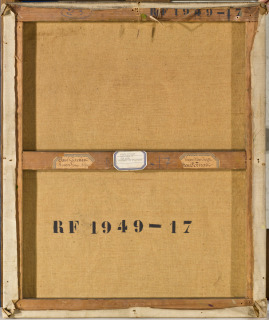
Portrait de l'artiste (détail), en 1889
Musée d'Orsay
Don de Paul et Marguerite Gachet, enfants du docteur Gachet, 1949
© Musée d’Orsay, Dist. RMN-Grand Palais / Patrice Schmidt
See the notice of the artwork
Artaud made a brief visit to the exhibition at the Musée de l'Orangerie and drew on its catalogue and on two books with colour illustrations – Vincent van Gogh with text by Wilhelm Uhde (Phaidon, 1936) and Anne-Marie Rosset's Van Gogh (P. Tisné 1941) - to immerse himself in the painter's work. He asked Paule Thévenin, who was helping him with his work, to read aloud Vincent's letters to his brother Theo. The text, made up of fragments in exercise books with revisions and improvised passages, was dictated between 8 February and 3 March 1947 to Paule Thévenin, who transcribed it. The book was published at the end of the year by K éditeur.
Drawing on Artaud's analysis and words, this exhibition adopts an entirely new approach to works by Van Gogh familiar to the poet, grouped according to his own descriptions.
The title of the exhibition is based on the title of Antonin Artaud's book, Van Gogh the Man Suicided by Society, © Editions Gallimard, 1974.
A terrible sensitivity

Portrait de l'artiste, Saint-Rémy-de-Provence, août-septembre 1889
Washington, The National Gallery of Art
Collection de M. et Mme John Hay Whitney
© Courtesy National Gallery of Art, Washington
"Van Gogh, a madman?
Let anyone who once knew how to look at a human face take a look at the self-portrait of Van Gogh [...].
Painted by an extra-lucid Van Gogh, that face of a red-headed butcher, inspecting and watching us, scrutinising us with a glowering eye.
I do not know of a single psychiatrist who would know how to scrutinise a man's face with such overpowering strength, dissecting its irrefutable psychology as if with a knife". The tragedy explained
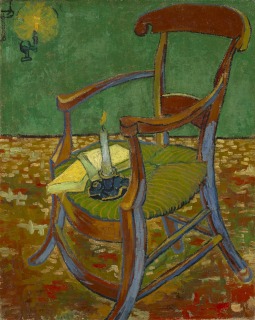
Le fauteuil de Gauguin, 1888
Amsterdam, musée Van Gogh
© Van Gogh Museum Amsterdam (Vincent van Gogh Foundation)
"A candlestick on a chair, an armchair with a green straw bottom,
a book on the armchair,
and there you have the drama lit up.
Who is going to come in?
Will it be Gauguin or another ghost?"
Around mid-November 1888, Van Gogh produced two paintings which form a pair: a plain yellow wooden chair with a straw seat and Gauguin's Chair painted in red and green - colours evoking night-time passions. He explained to his brother that they represented day and night, Vincent and Paul.
There is clear evidence of the tragedy which was brewing in this potent, metaphorical portrait of the friend who came to stay with him in Arles. According to Gauguin, Van Gogh threatened him with a razor a month later in a fit of nocturnal madness and then cut off the lobe of his own left ear and gave it to a prostitute.
Van Gogh later admitted that "The atmosphere between us had become electric".
According to Artaud, the violet shadow suffusing the chair represented the dividing line between two antagonistic personalities.
The sorcerer
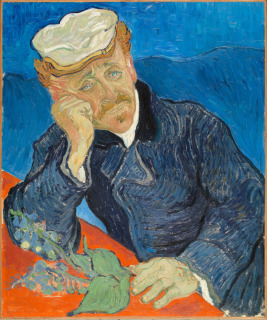
Le docteur Paul Gachet, en 1890
Musée d'Orsay
Don de Paul et Marguerite Gachet, enfants du modèle, 1949
© Musée d’Orsay, Dist. RMN-Grand Palais / Patrice Schmidt
See the notice of the artwork
"Yes, I think more than ever that it was to Dr Gachet, of Auvers-sur-Oise, than Van Gogh owed, that day, the day he committed suicide at Auvers-sur-Oise,
owed, I say, his exit from life, -
for Van Gogh was one of those natures whose superior lucidity enables them, in all circumstances, to see farther, infinitely and dangerously farther, than the immediate and apparent reality of facts".
Motivated by his hatred of doctors - and of psychiatrists in particular - Artaud stated that Dr Gachet (1828-1909) bore the brunt of the blame for Van Gogh's suicide. He claims that this "sorcerer", driven by a burning desire to satisfy his hatred and jealousy of this genius, urged him to paint to the point of exhaustion.
However, in the final months of his life, Van Gogh regarded Gachet as a friend. He found his "gentle, sad face" so interesting that he wanted to paint his portrait as soon as they met, as a modern depiction of melancholy in which the personality of the sitter was conveyed by colour alone, rather than by physical likeness.
From beyond the grave
"Van Gogh refused to tell stories in his paintings, but the marvelous thing is that this painter, who was only a painter, [...] presents for us, in front of the fixed canvas, the enigma pure, the pure enigma of a tortured flower, of a landscape slashed, plowed and pressed on all sides by his drunken brush.
[...]
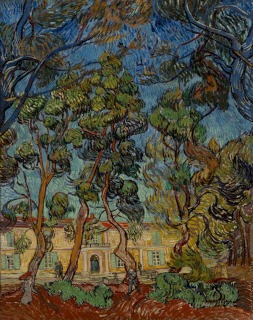
Arbres dans le jardin de l'hôpital Saint-Paul, octobre 1889
Los Angeles, Hammer Museum, The Armand Hammer Collection
Gift of the Armand Hammer Foundation
© The Hammer Museum. Photo: Brian Forrest
Why do Van Gogh's paintings make me feel as if I am seeing them from beyond the grave, from a world where finally his suns will have been the only things that spun round and lit up joyously?
For is it not the whole history of what was once called the soul which lives and dies in his convulsive landscapes and flowers?"
On 8 May 1889, Van Gogh left Arles definitively to settle in the Saint-Paul-de-Mausole hospice in Saint-Rémy-de-Provence where he was allowed outings until may 1890.
When he was to feable to paint in the outskirts of the town, the Romanic monastery housing the hospital and its gardens served as his motif. His views of the hospital show a tension between the straight lines of the buldings and the moving aspect of the vegetation growing in the park.
A quiet, convulsive man
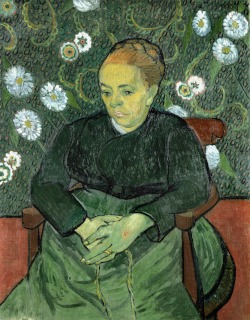
Augustine Roulin (La Berceuse), Arles, février 1888
Amsterdam, Stedelijk Museum
© Collection Stedelijk Museum Amsterdam
"For a long time pure linear painting drove me mad until I met Van Gogh, who painted neither lines nor shapes, but inert things in nature as if they were having convulsions. [...]
No one has ever written or painted, sculpted, modelled, built, invented, except to get out of hell.
And to get out of hell, I prefer the landscapes of this quiet convulsive man to the swarming compositions of Breughel the Elder or Hieronymus Bosch, who compared to him are only artists while Van Gogh is only a poor ignoramus determined not to deceive himself."
There are five versions of the portrait ofAugustine Roulin, the wife of the postman, a friend of Vincent.
He started painting the first one a short time before the nervous breakdown of 23 December 1888 that provoked the internment of the painter in Arles. This icon of maternity – represented without the child – is holding in her hand the string of a cradle situated outside the frame.
Behind the placid character, the flowzers of the wallpaper are swirling and seem to be animated by an autonomous and unsettling life, like a bad spell cast over the baby.
The common colour of things
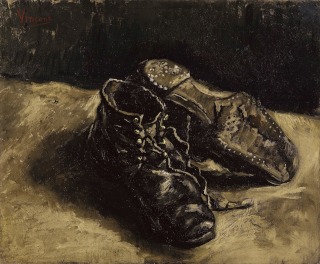
Paire de chaussures. Une chaussure retournée, paris, printemps 1887
Collection particulière, courtesy of Eykyn Maclean, LP
© Droits Réservés
"It is what strikes me most in Van Gogh, the most genuine of painters, who, without going any further in what is called painting, and what is painting, neither setting aside the tube, nor the paintbrush, nor the framework, nor the motif nor the canvas, in favour of anecdote, narration, tragedy, colourful plot, nor the intrinsic beauty of the subject or object, managed to imbue nature and objects with such passion that the fabulous stories of Edgar Allen Poe, Herman Melville, Nathaniel Hawthorn, Gérard de Nerval, Achim Arnim or Hoffmann say no more about the psychological and dramatic plane than these two-penny canvasses,
Most of his canvasses were of moderate dimensions as though he had chosen them that way on purpose. [...]
For this is the essence of Van Gogh, a single-minded concern for every stroke silently and poignantly applied. The common colour of things, but oh so right, so lovingly right, that no precious stones can equal its rarity".
Artaud the draughtsman
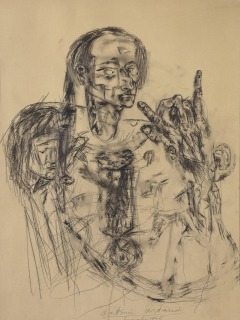
Autoportrait, décembre 1947
Paris, Centre Pompidou, Musée national d'Art Moderne / Centre de création industrielle
Legs de Mme Paule Thévenin, 1994
© ADAGP, Paris © Centre Pompidou, MNAM-CCI, Dist. RMN-Grand Palais / Philippe Migeat
Artaud began drawing in 1919, the year in which he was first prescribed laudanum to ease his physical pains and anxiety. From 1922 onwards, he produced sets and costumes for his theatre projects. His association with the Surrealists encouraged him to express himself by allowing his ideas to flow spontaneously from mind to hand via a pencil which drew complex lines on paper.
In 1945, Dr Ferdière, Director of the psychiatric hospital in Rodez and an exponent of art therapy, encouraged him to express himself on large sheets of paper measuring 50 x 60 cm. The big pictures sketched in colour in Rodez and the self-portraits produced in Paris in from 1946 onwards reveal the process of self-recreation initiated by Artaud to restore the fundamental unity of mind and body destroyed by his violent illness and electroconvulsive therapy. Their disjointed style reflects the power of this urge to be recreated.
Some sheets are exhalations from the body, choreography of meandering shapes, apparitions and mechanical lines, reminiscent of a danse macabre, while others look like arcane alchemists' texts. They all exude the power of a magic ritual despite the absence of linear narration. "I am [...] like poor Van Gogh, I no longer think, but every day I marshal tremendous inner turmoils." (Van Gogh, the Man Suicided by Society). Artaud's drawings, in which lines, signs and writings are inextricably bound together, are a distillation whose meaning transcends the images depicted.
What is drawing?
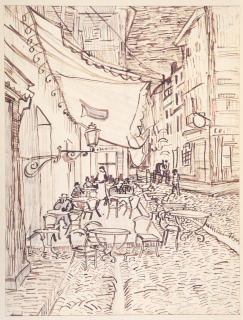
La Terrasse du café, place du Forum à Arles, la nuit, arles, septembre 1888
Dallas, Museum of Art
The Wendy and Emery Reves Collection 1985 R 79
© Image courtesy Dallas Museum of Art
"Like Van Gogh, Artaud wondered "How does one get there?" in relation not just to his own drawings but also to those produced by Vincent using broken lines, dots, cross-hatching, peaks of brown ink, coiled lines and splashes of watercolour to shape form, air and space and express a moment in life without constraining it.
"What is drawing? How does one get there? It's working one's way through an invisible iron wall that seems to stand between what one feels and what one can do. How can one get through that wall? — since hammering on it doesn't help at all. In my view, one must undermine the wall and grind through it slowly and patiently" (Letter from Vincent to Theo Van Gogh, The Hague, 22 October 1882, quoted by Artaud in Van Gogh, the Man Suicided by Society © Editions Gallimard, 1974)
Stormy light
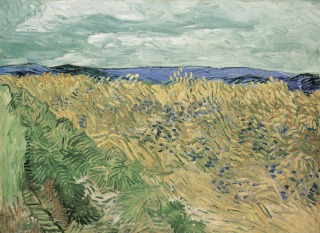
Champ de blé avec des bleuets, auvers-sur-Oise, juillet 1890
Riehen/Bâle, Fondation Beyeler, Beyeler collection
© Fondation Beyeler, Riehen/Basel, Beyeler collection
"Organist of an arrested tempest that laughs in limpid nature, pacified between two torments, but this nature, like Van Gogh himself, shows that it is quite ready to kick the dust from its feet.
After having seen it, it is quite possible to turn away from any other painted canvas, for it has nothing more to tell us. The stormy light of Van Gogh's painting begins its somber recitations at the very moment we have ceased looking at it.
Nothing but a painter, Van Gogh and nothing more, no philosophy, no mysticism, no rite, no psychurgie no liturgy,
no history, literature or poetry,
[...] but [...] to understand a storm in nature,
a stormy sky,
a plain in nature,
it will be forever impossible not to refer to Van Gogh."
During the summer 1890, Van Gogh painted many pieces representing wheat fields in the plain around Auvers-sur-Oise. "These are immense stretches of wheat under troubled skies and I shamelessly endeavoured to express sadness and extreme solitude", he wrote to his brother on 10 July 1890, only a few days before his suicide.
Landscapes of strong convulsions
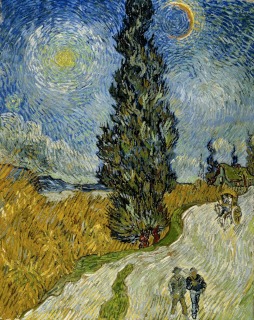
Route de campagne en Provence de nuit, 1890
Otterlo, collection Kröller-Müller Museum
© Kröller-Müller Museum
"Compared to a humanity of cowardly monkeys and wet dogs, Van Gogh's painting will prove to have belonged to a time when there was no soul, no mind, no consciousness, no thought, only raw elements alternately enchained and unchained.
Landscapes of strong convulsions, of insane traumas, like a body that fever torments in order to restore it to perfect health. [...]
Beware of Van Gogh's beautiful landscapes, whirling and peaceful,
convulsed and appeased.
This is good health between two bouts of a burning fever which will abate.
This is a fever between two recurrences of an outbreak of good health.
One day Van Gogh's painting, armed with fever and good health, will return to toss the dust of a caged world into the air, a world that his heart could no longer bear."
This nightscape of the outskirts of Saint-Rémy is probably the last Van Gogh painted during his stay in Provence.
The motifs lit by a thin moon crescent obscured by the shadow of the earth and by a star a shining as a sun vibrate as under the effect of cosmic forces, translated by swirling touches of fragmented colours.
All excerpts from: Antonin Artaud, Van Gogh, the Man Suicided by Society © Editions Gallimard, 1974
Vincent van Gogh. Timeline
1853
30 March, Vincent Willem Van Gogh is born in Zundert, in the southern Netherlands. He is the eldest son of the reverend Theodorus Van Gogh (1822-1885), a Protestant minister, and Anna Cornelia Carbentus (1819-1907).
1861-1868
At school, he learns English, German and French, and begins to draw.
1869
He begins an apprenticeship at the branch of art dealers Goupil & Co in The Hague run by his uncle. He will also work at the Goupil offices in London (1873 and 1874) and Paris (1874 and 1875).
1872
Begins a lifelong correspondence with his brother Theo.
1874-1876
Vincent develops a passion for the Bible and becomes an assistant preacher.
1879
He is an unpaid missionary in the Borinage minefields in the Walloon region of Belgium.
1880
Decides to become an artist and settles in Brussels, where he enrols at the Academy of Fine Art.
1881
Theo is appointed manager of Goupil's Paris office, and supports Vincent financially.
1883-1885
Vincent settles in Nuenen, in the southern Netherlands. During this period he produces The Potato Eaters.
His father dies unexpectedly.
1886
He briefly attends the Academy of Fine Art in Antwerp. Moves to Paris.
1886-1888
He lives with his brother and attends the Atelier Cormon art school.
Discovers the work of Monticelli. Befriends Emile Bernard, Toulouse-Lautrec and Pissarro, and meets Signac and Gauguin. He favours lighter tones and experiments with the new techniques developed by the Impressionists and Neo-Impressionists.
1888
Moves to Arles. He rents the Yellow House which becomes his studio and home. Gauguin joins him on 23 October to paint alongside him.
On 23 December, according to the sole witness, Gauguin, Vincent threatens him with a razor after a violent quarrel then cuts off part of his own left ear and gives it to a prostitute. He is admitted to hospital in Arles.
1889
On 18 April, Theo marries Johanna Bonger. In May, Vincent decides to commit himself to the Saint-Paul-de Mausole psychiatric hospital in Saint-Rémy-de-Provence. Recurrent bouts of illness are diagnosed by his doctor, Dr Peyron, as 'epileptic in nature'.
1890
31 January, birth of Theo and Jo's son Vincent Willem. In May, the painter moves to Auvers-sur-Oise, home of Dr Paul Gachet, a homeopathic practitioner, friend of Pissarro and modern art collector. He rents a room at the Auberge Ravoux inn.
On 27 July, he attempts to commit suicide by shooting himself in the stomach and dies two days later at the age of 37
.
Antonin Artaud. Timeline
1896
4 September, Antoine Marie Joseph Artaud, known as Antonin, is born in Marseilles.
His father Antoine Roi Artaud (1864-1924) is a master mariner and his mother Euphrasie Nalpas (1870-1952) is from Smyrna in Turkey.
His cosy childhood is disrupted by nervous complaints attributed to hereditary syphilis.
1919
Artaud paints and draws.
He is prescribed laudanum for the first time.
1920
The psychiatrist Edouard Toulouse encourages him to write.
He plays small roles at the Théâtre de l'Œuvre.
1921
Joins Charles Dullin's theatre company.
1922
Meets André Masson. Designs theatre sets and costumes.
1924
First film role. Meets André Breton and contributes to the journal La Révolution surréaliste.
1926
Artaud, Roger Vitrac and Robert Aron found the Théâtre Alfred Jarry.
1927
Expelled from the Surrealist circle.
1932
First manifesto of the Theatre of Cruelty.
1936
Artaud gives a series of lectures at the University of Mexico. Spends time in the Tarahumara sierras and is initiated to the peyotl ritual.
1937
Travels to Ireland. Arrested in Dublin for causing a public nuisance. He is committed in Le Havre and then in Sotteville-lès-Rouen.
1938
Publication of The Theatre and its Double.
Artaud is transferred to the Sainte-Anne psychiatric hospital in Paris.
1939
Committed to the Ville-Evrard psychiatric hospital until 23 January 1943.
1943
Committed to the psychiatric hospital in Rodez, in the unoccupied zone, run by Dr Gaston Ferdière, an exponent of art therapy. Mystical delusions. Electroconvulsive therapy.
1946
His friends intervene and Artaud leaves Rodez and moves to the clinic in Ivry run by Dr Achille Delmas, where there are no restrictions on his freedom.
Writes sections of Artaud le Mômo and works on a project for a Gallimard edition of his complete works.
Pierre Loeb suggests that he write about Van Gogh.
1947
13 January, a performance of L'Histoire vécue d'Artaud-Mômo at the Théâtre du Vieux- Colombier is cut short. Artaud suffers from stage fright and becomes aphasic.
24 January, the Vincent Van Gogh exhibition opens at the Musée de l'Orangerie in Paris.
He makes his first notes on Van Gogh directly into an exercise book.
2 February, Artaud visits the exhibition at the Musée de l'Orangerie with Paule Thévenin. He writes his essay in the Galerie Pierre. He dictates the text, which is partially improvised, to Paule Thévenin between 8 February and 3 March.
4-20 July, Artaud's exhibition Portraits et dessins at the Galerie Pierre.
22-29 November, Artaud writes and records the radio programme To Have Done with the Judgement of God. The broadcasting ban issued in February 1948 provokes outrage.
Circa 15 December, publication of Van Gogh, the Man Suicided by Society, which is awarded the Prix Sainte-Beuve in the essay category in January 1948.
1948
Diagnosed with inoperable rectal cancer.
4 March, Artaud is found dead in his room in Ivry, probably from an overdose of chloral hydrate. He is 51 years old.
